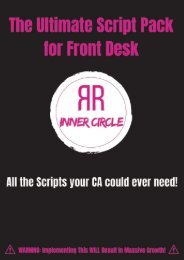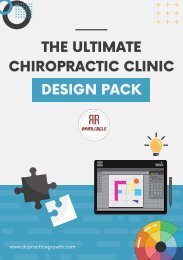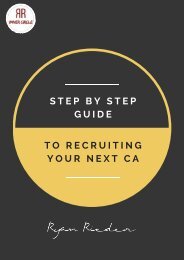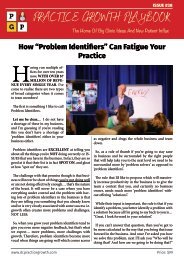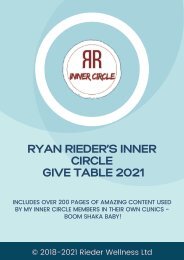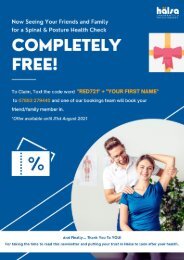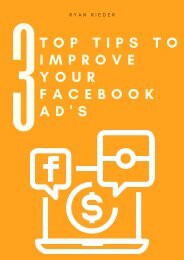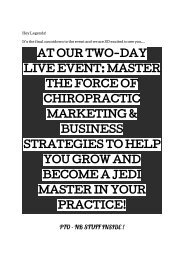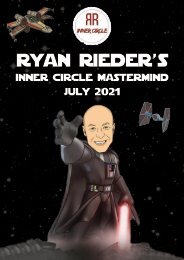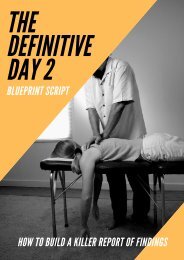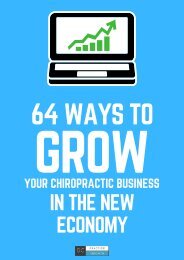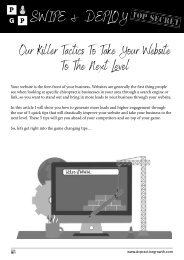You also want an ePaper? Increase the reach of your titles
YUMPU automatically turns print PDFs into web optimized ePapers that Google loves.
RYAN RIEDER INNER CIRCLE<br />
YOUR <strong>90</strong>-DAY<br />
MARKETING<br />
BLUEPRINT<br />
© 2018 - 2021 Rieder Wellness Ltd
CONTENTS PAGE<br />
Page 3: Welcome To Your <strong>90</strong>-<strong>Day</strong> <strong>Marketing</strong> Plan<br />
Page 6: Defining Your Perfect Patient<br />
Page 8: Creating Your Customer Journey<br />
Page 12: Working On Your Website<br />
Page 14: Mastering Your Lead Generation<br />
Page 19: Lifting The Smoke Screen…ing<br />
Page 21: Your <strong>90</strong>-<strong>Day</strong> Checklist<br />
The Information provided by Rieder Wellness Ltd is for general informational<br />
and educational purposes only and should be used as a model or guideline to base<br />
your work on and tweak where necessary.<br />
You should not rely solely upon the material or information as a basis for making<br />
any business, legal or any other decisions, and should ensure that any information<br />
you use sits in line with your own /governmental current legislative guidelines and<br />
procedures.<br />
Rieder Wellness Ltd accepts no responsibility and any reliance you place on such<br />
material is therefore strictly at your own risk.<br />
© 2018 - 2021 Rieder Wellness Ltd<br />
2
WELCOME TO YOUR <strong>90</strong>-DAY<br />
MARKETING PLAN<br />
Are you ready to make a big marketing push in your practice?<br />
Do you think your practice needs a jolt of energy, an influx of new patients, and an increase in<br />
revenue?<br />
YOU’RE NOT ALONE.<br />
The main thing you need is a sustainable marketing system that can fuel your growth for<br />
months, even years, to come. To achieve this, you’ll need to lay the groundwork with a strong<br />
marketing foundation.<br />
That’s why we made this <strong>90</strong>-day marketing plan for you.<br />
This will essentially give you the building blocks to put your marketing plan in place.<br />
So why do most “marketing plans” fail?<br />
The truth is, many marketing plans either fail completely or just don’t produce the desired<br />
results you were hoping for.<br />
Why?<br />
Well there are several reasons actually, but the key ones would be:<br />
• It wasn’t a GOOD plan in the first place<br />
• The plan was good, but wasn’t WELL-EXECUTED<br />
• It wasn’t given a chance to SUCCEED<br />
One big thing that leads to an unsuccessful plan is not understanding your target audience well<br />
enough. It’s a vital requirement of attracting the right people to your business, that you<br />
understand who your customers are.<br />
Without creating a good foundation and understanding your audience, you will run in to<br />
problems like having a poor content strategy or ineffective traffic-driving efforts.<br />
Execution is another important aspect to seeing success from your marketing plan. For<br />
example, marketing might be the plan, but do you have all the pieces in place to make your<br />
strategy work?<br />
Setting realistic goals is also important. You should know what you want out of your marketing<br />
plan so you can MEASURE, track PROGRESS and make as many ADJUSTMENTS as needed. Have a<br />
good idea of what a realistic timeline looks like for you. Strategies in marketing are not<br />
overnight success stories.<br />
© 2018 - 2021 Rieder Wellness Ltd<br />
3
Why a <strong>90</strong>-day plan?<br />
Why pick <strong>90</strong>-days as the timeline for your marketing plan?<br />
A full <strong>90</strong>-days has been found to be a realistic and achievable timeline for most businesses to<br />
put strategies in place and start to gain traction. It gives you time to get moving without<br />
feeling like you’re rushing the process.<br />
It’s basically “time-boxing”; focusing on the time you have, instead of the tasks you have. You<br />
allocate a certain amount of time to each activity, then only use the allocated time to get that<br />
task done.<br />
This helps to ensure that you devote enough time to doing something well, but not so much<br />
that you end up trying to over-engineer solutions.<br />
Our goal is to go through the different phases of marketing to build you a strong and<br />
integrated marketing plan that will set you up for long-term success and results.<br />
While this guide is intended to be a “step-by-step”, the truth is, every aspect should be<br />
revisited throughout the lifetime of your business and marketing work.<br />
Is this right for me?<br />
Well if you’re overwhelmed and feeling frustrated with what you are doing with your marketing<br />
at this moment in time, then…<br />
YES! This is most definitely for you.<br />
To quote Steve Jobs… “Simple can be harder than complex. You have to work hard to get your<br />
thinking clean to make it simple. But it’s worth it in the end because once you get there, you<br />
can move mountains.”<br />
Simple is not easy. Simple is a measure of complexity, easy is a measure of effort. We all know<br />
that marketing isn’t easy, but it can be very simple.<br />
If you’ve ever found yourself confused, frustrated or fed up by all the information that’s just<br />
floating around on the web that doesn’t seem to fit together, this is for you.<br />
And most importantly, if you don’t have in place right now an automated system that generates<br />
qualified leads on demand, in other words if you can’t go and spend money on Facebook and<br />
get a great ROI, then this is for you.<br />
Does that sound good?<br />
Great! Then let’s get started.<br />
What is your biggest struggle right now?<br />
© 2018 - 2021 Rieder Wellness Ltd<br />
4
If you could wave a magic wand and not have this friction in your life and your business, what<br />
would it be? The hardest part for anyone is not having the right system, not knowing how to<br />
get started with marketing and having difficulty being consistent.<br />
So, to overcome all of this you need to realise that there are a few things you need to put in<br />
place that’ll help you overcome your frustrations and tech overwhelm.<br />
How to I keep motivated?<br />
First off, you need to have the right mind-set. You need to have a mind-set that can help you<br />
immediately remove the mental obstacles and frustrations, so you can work on taking action.<br />
The reason why this matters is obvious. As a matter of fact, we’ve already touched on it.<br />
Most chiropractors have information overload. They’re drinking from a fire hose; taking in any,<br />
and all, information they can. All of this just causes overload.<br />
There’s also tech confusion…<br />
• What tools do you use?<br />
• What software should you use?<br />
• What should you do first?<br />
There’s so much misinformation that we find it hard to focus on what’s important, what’s<br />
needed. To be successful, you need to shut off the fire hose and go from drinking too much bad<br />
information and misinformation to doing the right steps in the right order.<br />
Use the resources you have and focus them on the simple things that are going to make all the<br />
difference in the world.<br />
What actually is a blueprint?<br />
It’s simply a plan of what you want to see happen in the future. It gives you a basic structure to<br />
work with toward success. And it’s very simple. But if you don’t have these blueprints,<br />
marketing can be very frustrating.<br />
This blueprint is going to provide a straight line to get from point A to point B. It’s the mindset<br />
piece, and it helps you to stay calm, clear, and confident no matter what type of market you<br />
practice in.<br />
I’m IN, what now?!<br />
So, let’s now delve in our 7-step plan to cover the next <strong>90</strong>-days in your practice. With these<br />
steps, even if you feel like you can tick half of them off, it will give you a clear structure and<br />
indication of what is important to focus on to ensure you operate a successful and thriving<br />
business with a marketing strategy that KILLS IT again and again.<br />
© 2018 - 2021 Rieder Wellness Ltd<br />
5
DEFINING YOUR PERFECT PATIENT<br />
A customer persona is a representation of your ideal customer that you build based on a mix of<br />
real data and educated speculation of what they look like. This includes information like<br />
demographics, goals, motivations and behaviours. Your business may have multiple target<br />
customer personas (most will have 3 - 5), and these will provide you with information that can<br />
guide your overall marketing strategy. For example, based on demographic information on a<br />
customer profile, you can determine the most likely online channels they will be using. The<br />
short answer of why you need to develop customer personas is that they will help you target<br />
your messaging across all stages of the customer journey. Your customer personas help you<br />
understand the specific goals and needs of your target audience at any stage. It’s about<br />
delivering clear, tailored messaging that resonates with your audience while avoiding a “spray<br />
and pray” approach.<br />
#1: Gather data<br />
The strongest customer personas are those that you create from real data and research. Making<br />
stuff up is a key mistake to avoid. Where can you gather the data you need? Here are a few<br />
suggestions:<br />
• Look for trends in your contacts database<br />
• Check your site analytics; where have visitors come from? What keywords are they using<br />
to search? Which pages do they spend the most time on?<br />
• Talk to your current customers<br />
• Who interacts with your customers? Talk to team members to get their input<br />
• Try social listening - This means observing and participating in conversations in social<br />
media groups or forums to discover the problems, questions and priorities people have<br />
© 2018 - 2021 Rieder Wellness Ltd<br />
6
A point to note here is that talking to customers is usually your best source of information. This<br />
means including customers who have been unhappy too - it’s important to understand exactly<br />
why they weren’t satisfied and whether it’s possible that they belong to a market segment that<br />
is just not a good fit for your product. Further, “negative” personas are a valid tool to have.<br />
It’s equally important to know who your product or service is not for. You can identify who you<br />
should exclude from your marketing.<br />
#2: Build out profiles<br />
Once you have gathered your customer (or market) data, it’s time to take that information and<br />
build out your buyer personas. We suggest sticking to no more than 3 - 5 profiles - any more is<br />
a lot to manage, and often unnecessary. You’ll find for example, that there will be job roles<br />
whose priorities overlap or who have similar problems. The key when you’re developing your<br />
personas is to be strict about only focusing on data that is relevant. We follow a very simple<br />
template to build out buyer personas and stick to 5 key groups of data. Using a template as a<br />
guide can help you to filter out any unnecessary information. In a nutshell, each persona will<br />
include:<br />
• Name<br />
• Demographic information - This might include location, job role, age group, gender and<br />
interests. Pick out only demographic data that is actually relevant to their need for your<br />
product or service<br />
• Goals, challenges, values and fears - Get an idea of what motivates them and what their<br />
priorities are.<br />
• Description of job and business - Understand the specific they role they’re responsible<br />
for within the business they work for.<br />
• Where to find them - This might include what they read, watch or listen to, groups they<br />
belong to, social channels they use or forums where they hang out.<br />
#3: Prioritise profiles where needed<br />
You might have a few different customer personas identified, but are all of them a priority for<br />
you right now? How do they align with what your current goals are as a practice? This is an<br />
important consideration as part of your <strong>90</strong>-day marketing plan. Do you create campaigns<br />
targeted at every persona you have, or do you target just one or two?<br />
#4: How to use your target customer personas<br />
Now that you’ve created your customer profiles, you have a ready-made way to go about<br />
market segmentation. This means you can proactively seek out conversations with those who fit<br />
within your personas. Begin with your current leads and customers, and then begin crafting<br />
messages that will resonate with them. This can come right down to the vernacular you use -<br />
what style of pitch is likely to get their attention? You can also use your personas to guide any<br />
cold outreach. You should now have an idea of where to find your target segments, so join<br />
them in the communities, forums, groups or conferences where they like to hang out. Write any<br />
marketing copy with your persona in mind. What sort of headline will grab their attention?<br />
Which topics do they want to hear about? A key takeaway here is that all marketing activities<br />
should be clearly defined with your target customers in mind. Reach them where they are and<br />
take a narrow focus - say goodbye to the “spray and pray” approach and welcome targeted<br />
results.<br />
© 2018 - 2021 Rieder Wellness Ltd<br />
7
CREATING YOUR CUSTOMER JOURNEY<br />
Making a connection with new prospects can be hard. As a business, it can prove to be one of<br />
the biggest challenges you can face! Have you ever felt that, despite your marketing efforts,<br />
you’re not reaching anyone? What about when you are reaching people, but no one is<br />
converting into a new patient?<br />
If you find yourself in either of those positions, you’re not alone. Many businesses are out<br />
there trying all sorts of tactics, jumping from one thing to the next, often unsure of what to<br />
work on next. What will finally be the “silver bullet” to connect with people and actually get<br />
them buying? A key thing to understand before diving into any new strategy is the position of<br />
your customer. Where exactly are they on their journey to discover and get to know you? This<br />
position should determine the types of messaging you are sending them.<br />
Mapping out your customer journey is another important task to complete early in your<br />
marketing plan. Doing so allows you to map the journey to specific marketing activities and<br />
assets, and prioritise how you work on your marketing plan.<br />
There are many different stages to the customer journey, that are positioned as a “series of<br />
interactions”, leading them down a path to become a patient.<br />
#1: Who?<br />
At the beginning, the potential customer doesn’t even know you but hopefully you have<br />
identified them using your customer personas. They will be exhibiting behaviours that you have<br />
determined may make them a prospect.<br />
#2: Awareness of their problems<br />
You could look at awareness as two distinct parts. First, you must assume the customer is a<br />
stranger to your practice. They become aware that they have a problem but they are not yet<br />
aware that you exist with a potential solution for them. This is problem awareness.<br />
© 2018 - 2021 Rieder Wellness Ltd<br />
8
Alternatively, perhaps they are not aware of their problem until they come across a piece of<br />
content, video or advertisement of yours that explains it clearly to them. Either way, they’re<br />
getting to that stage of problem awareness. That problem either prompts them to look for a<br />
solution or your marketing happens to find them at the right time.<br />
#3: Awareness of a solution<br />
The second stage of awareness is solution awareness… “Aha, so I have a problem and there<br />
are potential solutions available”. The prospect is now consuming content that highlights<br />
solutions and looking for customer case studies as proof.<br />
#4: Solution comparison<br />
Now that the customer is aware of the problem and that there are solutions available, they’re<br />
going to move on to consideration. This means they will research, compare solutions and try to<br />
find information that will lead them towards a decision. Remember that as prospects research,<br />
they will usually start to form a fair idea of which criteria do and do not meet their needs. They<br />
will probably have questions that they prioritise according to what they see as their greatest<br />
needs. They will use this information to narrow their focus and eliminate some of the<br />
possibilities that their research turned up.<br />
#5: The lead<br />
Once the customer has a shortlist of possible businesses, they’re ready to make the decision to<br />
select one to help them with their problems. They’re going to be thinking about how easy the<br />
solution is going to come-about and how the solution addresses their overall needs. This is the<br />
point where they officially become a “lead”. That could be a free offer, or a discounted<br />
consultation, or some other action they took to intentionally enter your funnel. Keep in mind,<br />
you don't have them just yet. It’s possible they’ve compared one or two other practices as part<br />
of their decision process - where you can really hang on to the customer is in the next stage.<br />
#6: Success mapping<br />
Many depictions of the customer journey end at the decision stage with “become a new<br />
patient” as the ultimate goal. If you look at the journey from the perspective of the customer<br />
though, this final stage, customer success is important. At this stage, it is about ensuring that<br />
the customer has all that they need to get a successful outcome from your product or service.<br />
Customer success is when your customers achieve their desired outcome through their<br />
interactions with you. Desired outcome is a function of the customer achieving what they need<br />
to while having an appropriate experience in doing so. This brings in all touch points that might<br />
be involved - care, sales, marketing, customer support and anyone else they might have contact<br />
with. The desired outcome may look slightly different for any given customer, but you can look<br />
to your customer personas and make some fair assumptions.<br />
Let’s think about “funnels” for a second…<br />
Where does your lead fit in your funnel? Firstly, you have “top of funnel”, this covers the<br />
period where a prospect is trying to solve a problem and is typically looking for information to<br />
figure out the best solution. When you look at the shape of a funnel, the “top” is at the widest<br />
point. This also illustrates the fact that you may get many leads here, but not all will continue<br />
with you through the journey. This is a period of qualifying leads to move on to the next stage<br />
- usually they will disqualify themselves.<br />
© 2018 - 2021 Rieder Wellness Ltd<br />
9
Next you have the “middle of the funnel”. This is where prospects might become genuine<br />
leads. It aims to show customers why your product or service should be their first choice.<br />
Typically, you would be following strategies to capture their information, such as by getting<br />
them to sign up for an offer. By the end of this stage, you should have a fair idea of whether<br />
they are ready to become a patient.<br />
Last is the “bottom of the funnel”. This stage is very simple; it is where the sale takes place.<br />
The customer is on the phone booking their appointment with you, they are receiving follow-up<br />
emails and texts to ensure they follow-through with their buying decision.<br />
© 2018 - 2021 Rieder Wellness Ltd<br />
10
You can probably see from the different stages of the customer journey that, as the customer<br />
has different needs and expectations at each stage, you will need to meet those with different<br />
marketing strategies. We like to create a customer journey map and integrate our marketing<br />
plan. For each stage of the journey we would follow these steps:<br />
• Determine your goals - For example, at the “problem awareness” stage a goal might be<br />
to educate the customer that solutions exist to their problem.<br />
• Decide on the activities that help those goals - Following on from the example of<br />
educating the customer, an activity might be writing posts targeting specific pain<br />
points.<br />
• Create measurable marketing objectives - For example, you might tie a goal to the<br />
number of visits to your content.<br />
• Create to-dos and prioritise - What tasks do you need to get done to make these<br />
activities happen?<br />
If you’ve found that potential customers just don’t seem to be getting the message, there’s a<br />
chance that they’re seeing the wrong message at the wrong time. Depending on where they are<br />
in their journey, they have different needs and expectations, which is why it’s important to<br />
create marketing messages that cater to different parts of the funnel. Your aim should be to<br />
make a real connection with people, meeting them at their own stage, before guiding them<br />
through the rest of the journey. Start mapping out your customer journey today and consider<br />
how you can engage each stage.<br />
After all, the customer is the hero, we are the guide. It is our job to get them from A to B, all<br />
the while making them feel like they are special and being treated like the only customer in the<br />
world.<br />
© 2018 - 2021 Rieder Wellness Ltd<br />
11
WORKING ON YOUR WEBSITE<br />
At this point, it is to be assumed you have a website? If not, quick, your business will not be a<br />
success without one…!<br />
Now, we know time and energy will have gone in to the design of it; colours, font, layout, until<br />
you have the perfect site. And then…<br />
NOTHING.<br />
Your conversion rate is laughable and you’re thoroughly disappointed. Why is my amazing<br />
website not producing new patients for me? The problem is that it is not OPTIMISED correctly<br />
for traffic lead capturing. Great designs do not equal new patients.<br />
So here are 4 things you can do to optimise your website to ensure you are generating leads<br />
every day and all you have to do is sit back, relax and enjoy the fruits of your labour.<br />
#1: Optimise your homepage<br />
How quickly does someone who lands on your homepage understand what you’re all about?<br />
There are so many examples of websites out there which require clicking around or perhaps<br />
browsing through reference material in order for the visitor to know what they do. The point is,<br />
most people won’t bother. If you can’t capture their attention within a few seconds, they will<br />
be gone. Key information needs to be presented upfront so that the visitor can clarify that they<br />
are in the right place. For your website, this means leading with the pain or problem you are<br />
solving and getting to the point very quickly. Your audience should be able to identify within<br />
seconds that your product or service might be right for them.<br />
#2: Crackdown on good copy<br />
Copywriting is a great skill to hone in on as it is the language that actually sells your product or<br />
service. A common mistake that people make on their websites is to base a lot of their copy on<br />
describing their features, without enough going into highlighting the benefits for their<br />
customers. “What’s in it for me?” is a question which should be addressed upfront. Your<br />
benefits should go back to those pain points that your product or service is solving.<br />
#3: The proof is in the (social) pudding<br />
We all want to know that other people are using and having success with a service before we<br />
buy. Social proof is a powerful tool to help sell your product and reassure people that others<br />
like using it. We also call it “testimonials”; videos of your current patients highlighting how<br />
you have helped them with their health.<br />
#4: Called to action<br />
Your “calls to action” are the words or sentences that compel people to take action with you.<br />
They also help to make it clear to the customer what you’d like them to do - don’t make them<br />
guess! It is always good to test your calls to action, to see what works best for you. Focus on<br />
appearance – does it stand out with a noticeable button? Colours are another thing that can be<br />
tested. Size - is the button big enough? Does making it larger or smaller make any difference?<br />
Copy - test different versions of copy. A tip here is to use language that invites the customer to<br />
© 2018 - 2021 Rieder Wellness Ltd<br />
12
go further on their journey. Don’t use language that sounds too final or rushed, such as “buy<br />
now”. That sort of language is better left to sale sites where scarcity is a factor. Another tip is<br />
to say exactly what it does - vague language like “submit” doesn’t tell the customer what’s<br />
going to happen.<br />
#5: Pixel perfect<br />
You may have heard of a little thing called a “Facebook Pixel”…? This is a piece of code, that<br />
once installed on your website, can track activity on your site and can later be used in your<br />
targeting with adverts on the social media site. This is great for re-targeting people who may<br />
have not been “ready” at the time of visiting your site and need an extra nudge in the right<br />
direction. You can show them things like testimonials, informational videos or an offer for care.<br />
Not only that though, you can be really specific with the content. Using a pixel can show you<br />
exact pages that have been visited, so not only will you know that they’ve visited your site,<br />
you’ll know if they looked at the back pain page, or the sciatica page, then you can utilise that<br />
knowledge to show that audience a back pain themed testimonial video.<br />
So as long as you work on your homepage, to lead the problem you are helping to solve and<br />
make sure your website traffic can understand within a few seconds who you are and what<br />
you’re about, you are good to go! Adding in better copy, some social proof and plenty of<br />
optimised calls to action, you can have a great site that works to produce you new patients.<br />
A website is all about balance and there are two main objectives that need to be met on a<br />
website. You have to think about what your customer wants from their visit and what do you<br />
want from their visit. For the customer, they are likely visiting your website to learn. They are<br />
somewhat interested in your product or service and would like more information. You cannot<br />
have one without the other and this is where so many websites go wrong.<br />
© 2018 - 2021 Rieder Wellness Ltd<br />
13
MASTERING YOUR LEAD GENERATION<br />
Now you know who you want to target with your marketing and you’ve tidied-up your website,<br />
it’s time to think about what other lead generation there is for you to do, to get those new<br />
patients flooding through the front door.<br />
But the point of this blueprint is about having a STRATEGY. And a clear one at that. Without<br />
one, you’ll just be jumping from one idea to another; trying every cool, shiny new tactic that<br />
comes your way. Without the correct strategy, you won’t have a nice flow of leads coming<br />
through to your practice.<br />
This is about shifting you from a manual process to putting your marketing in to auto-pilot!<br />
Everything in this blueprint is honestly very simple to achieve, you don’t need to be a complete<br />
nerd with all the systems and software. The main thing with lead generation is that you’re<br />
implementing it without too much overwhelm. Please note that you should not be thinking<br />
about this next stage if the foundations of what we have gone through up until this point are<br />
not in place. If you don’t have your foundation in place first, you have no business running<br />
Facebook adverts or the like.<br />
We ultimately want you to grow your practice with proven methods that generate you new<br />
patients over and over. To truly master the lead generation game, don’t just focus on ONE<br />
THING. You may have heard, but “one” is the worst number in business. You have to have<br />
multiple fingers in multiple pies to have your message spread to as wide an audience as<br />
possible.<br />
#1: The Ideal Patient<br />
Once you’ve worked out your ideal patient, you must ride with it at the forefront of your lead<br />
generation. This is essential and makes sure you’re focused on the right type of patient from<br />
the start because if you’re marketing to everyone you’re really marketing to no one. It will just<br />
be lost in a sea of marketing from hundreds of other adverts.<br />
#2: The Ideal Message<br />
Your message is a clearly stated message that speaks directly to the ideal patient you’re trying<br />
to attract. You have to say… “Here’s what I do and here’s how it can help you”, but most<br />
importantly, it needs to connect with your ideal patient so that they get the results they really<br />
want.<br />
#3: The Ideal Solution<br />
This is a simple way to show your potential customers how you can get them from where they<br />
are to where they want to be; taking them from their biggest pain point to their biggest<br />
achievement.<br />
#4: The Ideal Offer<br />
You want to be attracting people with a great and low-risk offer. You want to be generating<br />
leads as quickly and as efficiently as possible. Setting the terms of your offer too high will not<br />
© 2018 - 2021 Rieder Wellness Ltd<br />
14
e the most attractive thing to your potential customers. The offer needs to be something you<br />
can use again and again, and that is easy to implement in to your main driving force.<br />
#5: The Ideal Lead Magnet<br />
Lead magnets come in all shapes and sizes. It needs to be punchy, solving only one problem. It<br />
has to position you as an expert, be time-friendly so they can consume it within minutes and it<br />
needs to be “un-finished”, meaning it’s only one part of the main solution to their problem.<br />
#6: The Ideal Funnel<br />
A sales funnel allows you to streamline the marketing lifecycle. If you look at your marketing<br />
funnel, all you’re trying to do is move people through a series of steps; from an opt-in form to<br />
a thank you page to scheduling a new patient appointment with you.<br />
#7: The Ideal Advert<br />
At first, just stick with one advert source, test it, refine it and reap the benefits from it before<br />
moving on to a different one. On Facebook, for example, try a lead generation advert and then<br />
a traffic advert for an in-house talk, then once you’re happy you can run the winning adverts<br />
alongside each other, turning them on and off like a tap.<br />
There are many types of lead generation you can implement but the key strategies that you<br />
want to implement in the next <strong>90</strong>-days are as follows:<br />
Lead Generation Carousel Advert<br />
A lead generation carousel advert that is promoting a desirable offer to become a new patient<br />
in your practice. Here are the steps to set up your first lead generation advert:<br />
• Set up a Business Manager<br />
• Add your Business Page<br />
• Add an Ads Manager<br />
• Take some photos of your offices, including an adjustment photo and a team photo (4<br />
minimum)<br />
• Decide on an offer i.e. £30 instead of £110, 70% off, buy one get one half price<br />
© 2018 - 2021 Rieder Wellness Ltd<br />
15
• Go to your Ads Manager and begin a NEW CAMPAIGN<br />
• Select the campaign type as “Lead Generation”<br />
• Name your campaign as “[Clinic Name Here] Lead Gen Ad”<br />
• Name your AD SET as “[Insert Offer Here] Offer 25-65+”<br />
• Select the correct Business Page you’d like to associate the advert with<br />
• Decide your audience based on your clinic location AND set the age range as “25-65+”<br />
• Go to the PLACEMENT section and select “Edit Placements”<br />
• Remove all placements EXCEPT from “Facebook Feeds”<br />
• On the BUDGET & SCHEDULE section, set a daily budget of between £10-£20 and let the<br />
ad run until you manually stop it<br />
• Continue to the next section<br />
• Give your advert a name<br />
• Select the format of your advert to be “carousel”<br />
• Insert the text copy for your advert, including the offer and what is included<br />
• Insert and add your 4 images<br />
• Add headlines to each of the images<br />
• Add emojis to the text copy and the headlines, go to get emoji.com to source the<br />
emojis<br />
• Change the CALL TO ACTION button to “Get Offer”<br />
• Select “+ New Form” to add a new LEAD FORM<br />
• Give the form a name<br />
• Go to “Form Settings”<br />
• Change the default language to “English (UK)” or your relevant language<br />
• Change “Sharing” from RESTRICTED to OPEN<br />
• Click on “Content”<br />
• Under “Info”, add a form headline<br />
• Change the setting under “Image” to “Use the image from your ad”<br />
• Add an information paragraph under “Layout”<br />
• Click on “Questions” and add a headline<br />
• Under USER INFORMATION, click on “see more options”<br />
• Select “Phone number”<br />
• Click on PRIVACY POLICY<br />
• Under “Link Text”, put “Privacy & Policy”<br />
• Under “Link URL”, add a link to your website’s privacy policy<br />
• Click on “Thank You Screen”<br />
• Add a HEADLINE and a DESCRIPTION<br />
• Set “Button Type” to CALL BUSINESS<br />
• Change “Button Text” to “Call [CA Name Here] Now”<br />
• Now add your phone number<br />
• Click SAVE and then FINISH<br />
• Now click on CONFIRM<br />
© 2018 - 2021 Rieder Wellness Ltd<br />
16
Traffic Advert<br />
A traffic advert that is promoting an in-house event in your practice such as a health workshop<br />
or a spinal screening. Here are the steps to set up your traffic advert, driving people to an inhouse<br />
health class:<br />
• Select a Health Workshop topic<br />
• Select a date and a time<br />
• Download an image relating to your event topic, use shutterstock.com etc.<br />
• Record a 30-second to 1-minute video inviting people to attend your workshop<br />
• Upload the video to YouTube and once uploaded, set the video to private<br />
• Under the video settings, go to “subtitles and captions”<br />
• Edit to captions and then save the edited version<br />
• Open the new version and export them as a .SRT file and name them “captions.en_US”<br />
• Create an Eventbrite account<br />
• Create a new event on Eventbrite<br />
• Give your event a title<br />
• Select the location/venue of your event<br />
• Select a start and end time/date<br />
• Give your event a header image, related to your talk topic<br />
• Give your event a description i.e. what the topic is, what they will learn and how it will<br />
help them<br />
• Add the organiser of the event and a description about them<br />
• Select the ticket type as “Free Ticket”<br />
• Name the tickets “General Admission” and set the seating capacity<br />
• Under ticket settings, set the sale end date as the event date<br />
© 2018 - 2021 Rieder Wellness Ltd<br />
17
• Add a ticket description<br />
• Under “Additional Settings”, set the event type to “Seminar or Talk” and set the event<br />
topic to “Health and Wellness”<br />
• Tick the box under “Remaining Tickets”<br />
• Click “Save”<br />
• Click “Make Your Event Live”<br />
• Under the event manager, click on “Order Options” under the event dashboard<br />
• Select “Order Form”<br />
• Select “Each Attendee”<br />
• Set “Mobile Phone” as “Include” and “Require”<br />
• Deselect “Address”<br />
• Click “Save”<br />
• Select “Order Confirmation” under “Order Options”<br />
• Add a “message” and an “email”<br />
• Click “Save”<br />
• Select “Invite and Promote” under the event dashboard<br />
• Select “Tracking Links”<br />
• Rename it “Facebook” and then save it<br />
• Select “Manage Attendees” under the event dashboard<br />
• Select “Emails to Attendees”<br />
• Add two new emails, with one sending 5 days before and one sending 3 days before<br />
• Go back to your “Tracking Links”<br />
• Copy the Facebook link<br />
• Go to your ads manager and create a new campaign<br />
• Select “Traffic” as the campaign type and name it “Health Workshops”<br />
• Name the ad set as “[EVENTNAME_DATE]”<br />
• Select your Traffic setting as “Website”<br />
• Decide your location and audience demographics<br />
• Edit your ad placements and delete all but “Facebook Feeds” and Facebook Right<br />
Column” Set a lifetime budget, between £100-£300 (an advisory amount)<br />
• Set the end date as the date of your event<br />
• Proceed to the ad set-up<br />
• Name your advert<br />
• Select your correct business page<br />
• Select the format as “Single Image or Video”<br />
• Upload your video<br />
• Add your saved captions<br />
• Add text copy to your advert<br />
• Paste the copied URL from Eventbrite under “Website URL”<br />
• Add a headline<br />
• Change your “Call To Action” to “Book Now”<br />
• Add a newsfeed link description and then click “Confirm”<br />
© 2018 - 2021 Rieder Wellness Ltd<br />
18
LIFTING THE SMOKE SCREEN…ING<br />
The final piece of your <strong>90</strong>-day marketing puzzle are an element known as screenings. These fall<br />
under the category of “field marketing”. You have “online marketing”, which refers to<br />
advertising done on social platforms; whereas “field” refers to marketing done out and about,<br />
speaking to people.<br />
A screening is an inside or outside event where you set up a stall or kiosk and offer “passerby”<br />
trade an opportunity to get a “posture check” or “spinal assessment” with you. The<br />
prospect is then offered an opportunity to come in to your practice for an initial appointment at<br />
a reduced rate that they pay for at the event to secure their slot.<br />
As well as standard screenings, these can also be community events and corporate visits. They<br />
can be hosted anywhere, as long as you have your screening kit, some discounted vouchers and<br />
a thirst for new patients! From outside your practice’s front door to inside a well-known local<br />
business. Some of the best places to screen in include:<br />
• Fairs<br />
• Fetes<br />
• Markets<br />
• Shopping centres<br />
• Town centre<br />
• Supermarkets such as Tesco, Sainsburys etc<br />
• Local stores in your community<br />
• Gyms<br />
• Bigger corporate businesses<br />
One of the campaigns that will arguably bring you amongst the lowest cost per lead out of all<br />
media channels, screenings are a fantastic way of meeting new patients, networking with your<br />
© 2018 - 2021 Rieder Wellness Ltd<br />
19
community and spreading knowledge of you and your practice. It can be quite a passive<br />
marketing source, with a lot of attention coming from the customer than you, the marketer.<br />
Now, out of all the sources of new patients that exist, this is by far the least “sexy”, but by far,<br />
one of the biggest bankers. If you’re prepared to…<br />
• Serve more people in your community<br />
• Make way more money<br />
• Increase the time you have available in your life<br />
• All the while, decreasing stress in your day to day life<br />
THEN SCREENINGS ARE A MUST!<br />
The biggest secret to making screenings a success is very simple. Just show up. Quite literally,<br />
that is it. The more you show up, the more you learn, the better and more confident you’ll get.<br />
There are some great advantages to hosting a screening too. You have many venues you can<br />
contact and choose from, whereas you are limited to particular sites using online marketing.<br />
Another good thing is the customer pays before they’ve even stepped foot in your practice,<br />
meaning the likelihood of their retention is increased. You also get to create a nice rapport<br />
with them before their first appointment which is nice when they see your familiar face on<br />
attending their appointment.<br />
If you’re feeling good about the prospects of hosting a screening, but unsure of where to start<br />
and more importantly, what you need, we have created a nice checklist for you here:<br />
The Definitive Screening Checklist<br />
• SAM Machine<br />
• Poles<br />
• Roller Banner<br />
• Table<br />
• Table Cover<br />
• Spine and a stand<br />
• Vouchers<br />
• Booking Forms<br />
• Control Sheets<br />
• Clipboards<br />
• Method of Payment<br />
• Stapler and staples<br />
• Till Roll<br />
• Pens<br />
• Public Liability Insurance<br />
• Gazebo (if outdoors)<br />
• Sand Weights (if outdoors)<br />
• Chairs<br />
• Wooden Platform/Base<br />
© 2018 - 2021 Rieder Wellness Ltd<br />
20
YOUR <strong>90</strong>-DAY CHECKLIST<br />
WEEK 1:<br />
Gather data on your current patients<br />
Build a perfect patient profile<br />
Decide a profile to focus on<br />
Plan out the best message to use to attract<br />
your chosen target patient type<br />
WEEK 2:<br />
Structure your customer journey<br />
Decide the route in, the process and the<br />
Outcome<br />
WEEK 3-5:<br />
Re-structure your website’s homepage<br />
Check you are happy with the copy and<br />
edit where necessary<br />
Add social proof and testimonials to the site<br />
Add 2-5 “call to action” opportunities<br />
Set up and install a Facebook pixel on the site<br />
© 2018 - 2021 Rieder Wellness Ltd<br />
21
WEEK 5-8:<br />
Set up Facebook and an ads manager<br />
Decide an offer to promote<br />
Create a lead magnet<br />
Advertise an offer to your audience<br />
Promote a lead magnet to your audience<br />
Create a follow-up system for your leads<br />
Organise an in-house health class<br />
WEEK 8-12:<br />
Order and acquire a screening kit<br />
Book 5-10 screening events<br />
Attend and screen your local community<br />
Book new patients and create a follow-up<br />
for non-booked leads<br />
Hire extra help to join you at screenings<br />
© 2018 - 2021 Rieder Wellness Ltd<br />
22
Skyrocket<br />
Your Way To<br />
Success!<br />
© 2018 - 2021 Rieder Wellness Ltd<br />
23




